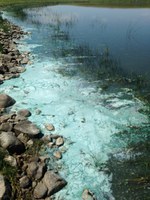Summer brings increased risk of toxic cyanobacteria
(Click the image below to view a high-resolution image that can be downloaded)
Cyanobacteria, also known as blue-green algae, can produce toxins that are harmful to livestock, wildlife and people. North Dakota State University Extension specialists have received reports of cyanobacteria blooms in livestock water sources.
Miranda Meehan, NDSU Extension livestock environmental stewardship specialist, says the growth of this bacteria is facilitated by high temperatures.
“The hot, dry conditions projected for July are perfect for the production of cyanobacteria,” says Meehan.
Additionally, the North Dakota Department of Environmental Quality recently reported a cyanobacteria bloom on McDowell Dam. For a list of reported blooms, visit their website at https://deq.nd.gov/WQ/3_Watershed_Mgmt/8_HABS/Habs.aspx.
Cyanobacteria is caused by an excess of nutrients, particularly nitrogen and phosphorus. Manure and commercial fertilizers are spread to enhance forage and crop production. When these products are misused, either by inappropriate rate or timing of application, the potential for nutrient leaching to surface water is increased. When these nutrients enter surface water, they stimulate growth of cyanobacteria and other microorganisms.
Blue-green algae often occurs in stagnant ponds or dugouts with elevated nutrient levels, forming large colonies that appear as scum on or just below the water surface. Live cyanobacterial blooms can be green, but also red or yellow, and often turn blue after the bloom dies and dries on the surface or shoreline, according to Meehan.
Some species of cyanobacteria can be toxic when livestock and wildlife ingest them. Toxicity is dependent on the species consuming the water, the concentration of the toxin or toxins and the amount of water ingested.
Cyanobacteria can produce neurotoxins and liver toxins. Signs of neurotoxin poisoning can appear within five minutes to up to several hours after ingestion. In animals, symptoms include weakness, staggering, muscle tremors, difficulty in breathing, convulsions and, ultimately, death.
Animals affected by liver toxins may exhibit weakness, pale-colored mucous membranes, mental derangement, bloody diarrhea and may ultimately die. Typically, livestock are found dead before producers observe symptoms. If cyanobacterial poisoning is suspected as the cause of death, producers should check the edges of ponds for dead wildlife.
Jake Galbreath, NDSU Extension veterinarian and livestock stewardship specialist, advises any farmer or rancher who suspects cyanobacteria poisoning as the cause of a livestock death to contact a veterinarian to conduct a necropsy.
“A veterinarian can determine which samples would be appropriate for each situation,” says Galbreath.
When collecting a water sample, follow NDSU Extension’s livestock water testing guidelines at ndsu.ag/watertesting.
Be sure to wear gloves, as cyanobacteria can be toxic to humans. Collect a sample of the suspected cyanobacterial bloom from the surface of the water and deeper in the water. The sample should be kept cool, but not frozen, and submitted to the NDSU Veterinary Diagnostic Laboratory or a commercial laboratory.
The sample can be evaluated microscopically for algae, or the water can be analyzed for several of the toxins at commercial labs at a higher cost.
For more information on sample collection and submission, contact your NDSU Extension agent.
Galbreath provides some ways farmers and ranchers can prevent cyanobacterial poisoning of livestock:
- Reduce nutrient levels entering the water source by implementing a nutrient management plan or establishing buffer strips with perennial plant species.
- Create a designated drinking area where the risk of cyanobacteria is minimal.
- Fence off the pond and pump water from the pond to the water tank.
- Use water from other sources following periods of hot, dry weather.
- Pump water from the center of the water body well below the surface, where the bacteria are unlikely to concentrate, to a water tank.
Unfortunately, unless steps are taken to reduce the nutrient load and minimize the potential for nutrients to enter the water body, there will continue to be a risk for cyanobacterial blooms.
Meehan provides management practices to consider to reduce nutrient loads:
- Properly apply nitrogen and phosphorus to fields. Rate, time and amount and type of nutrients applied need to be considered.
- Adapt soil conservation practices that reduce erosion.
- Install hay or graze buffer strips to reduce the release of phosphorus as plants decompose.
Contact your local NDSU Extension agent for more information on cyanobacteria and nutrient management. Additional information regarding water quality can be found at https://www.ndsu.edu/agriculture/ag-hub/ag-topics/natural-resources-and-facilities/water.
Information about the June storm recovery can be found at https://ndresponse.gov/be-prepared/severe-summer-weather/2025-june-storm-recovery.
NDSU Agriculture Communication – June 30, 2025
Source: Miranda Meehan, 701-219-9251, miranda.meehan@ndsu.edu
Source: Jake Galbreath, 701-231-5738, justin.galbreath@ndsu.edu
Editor: Dominic Erickson, 701-231-5546, dominic.erickson@ndsu.edu


